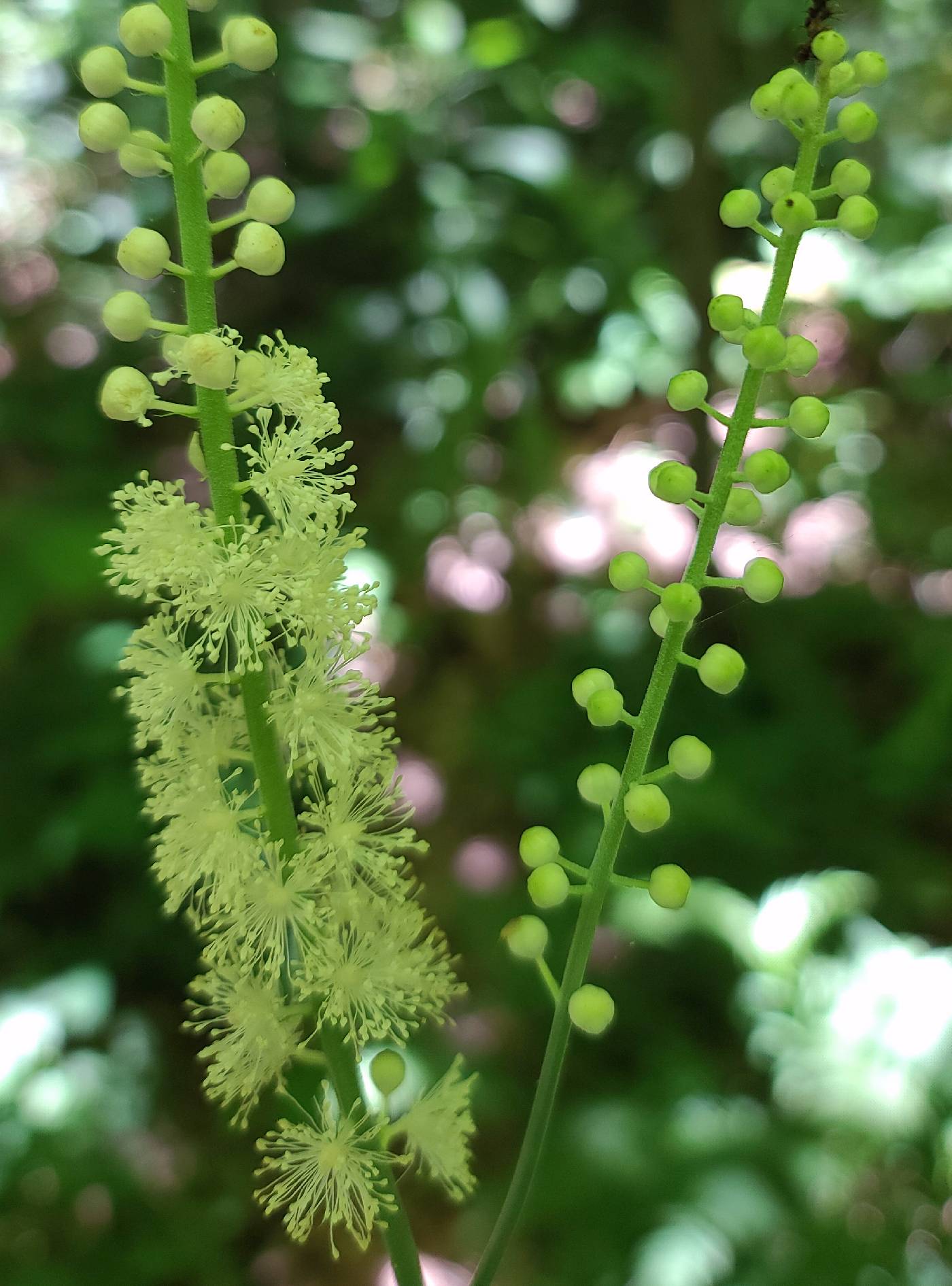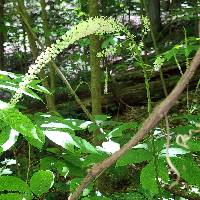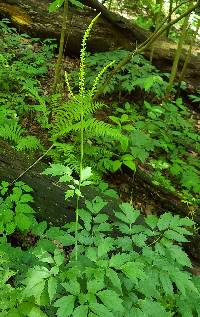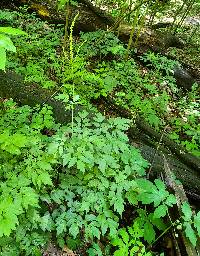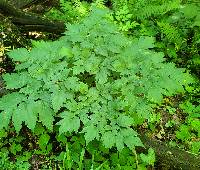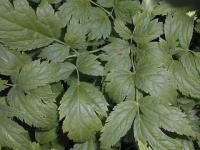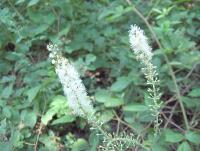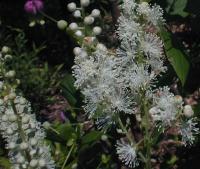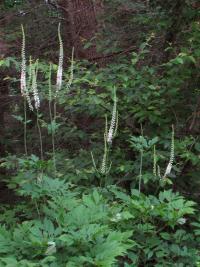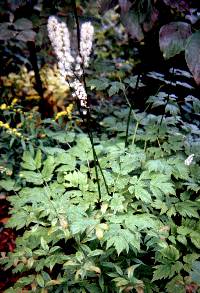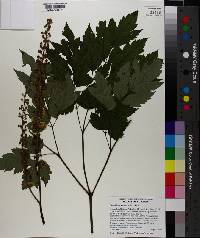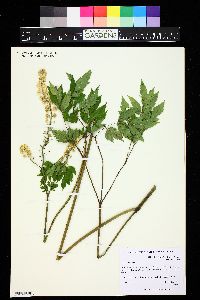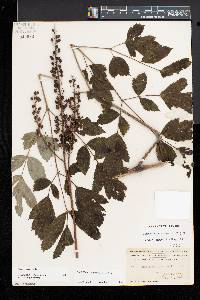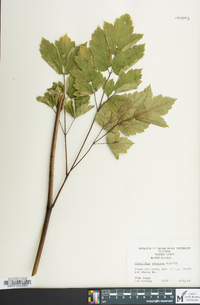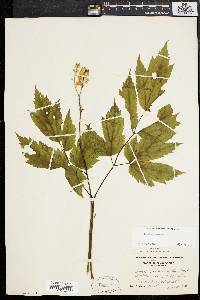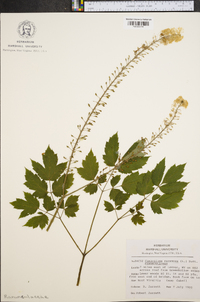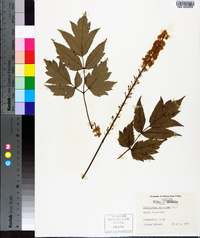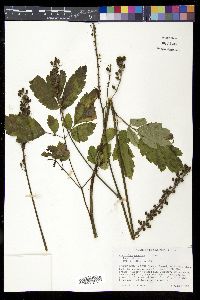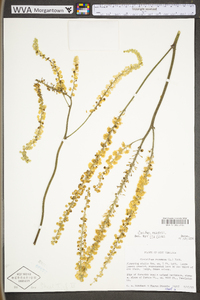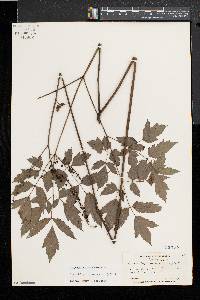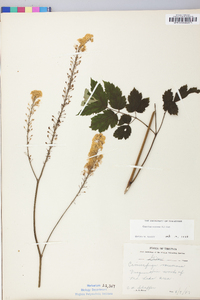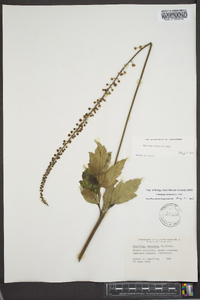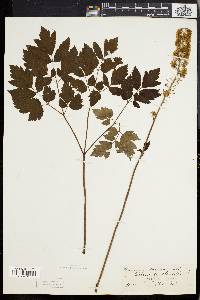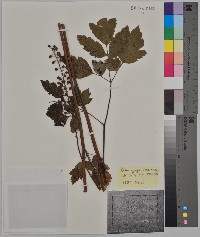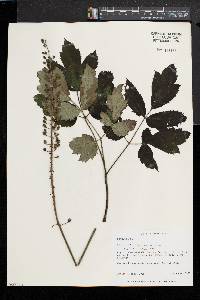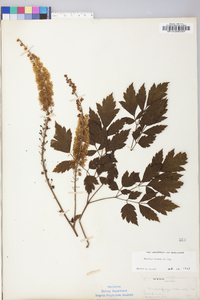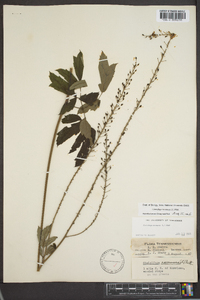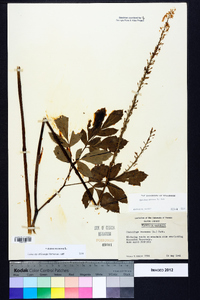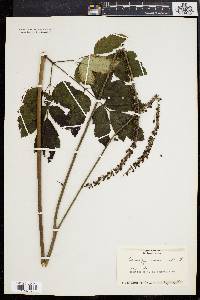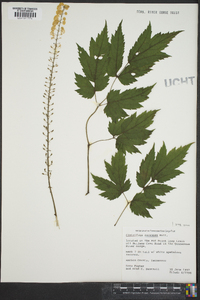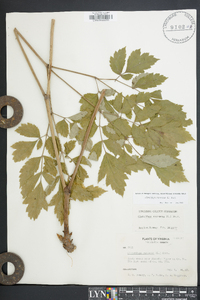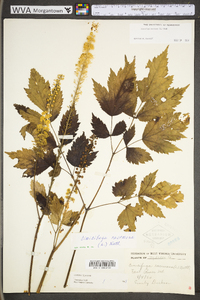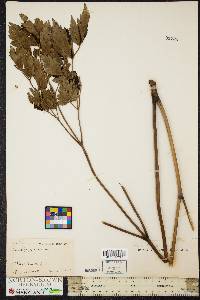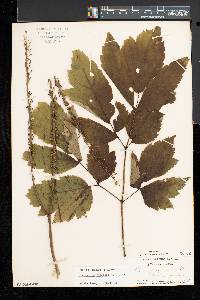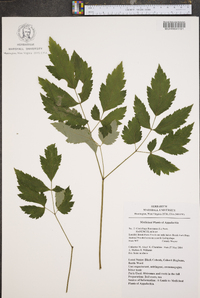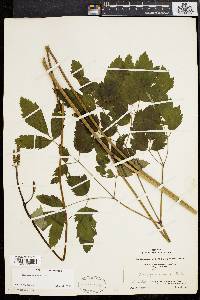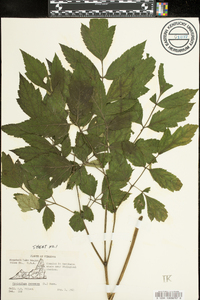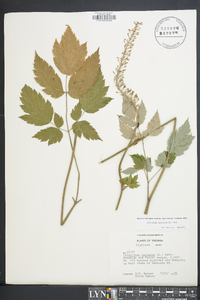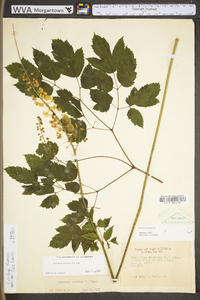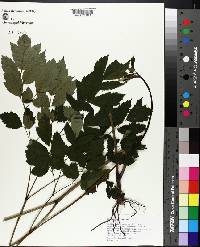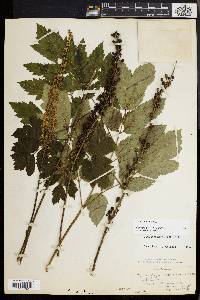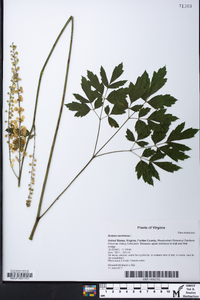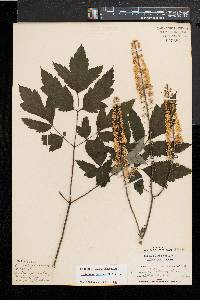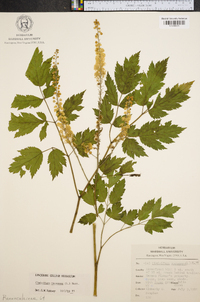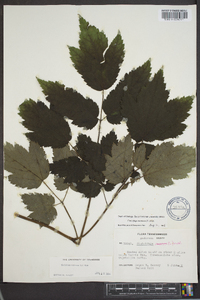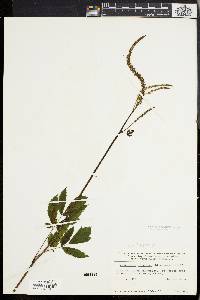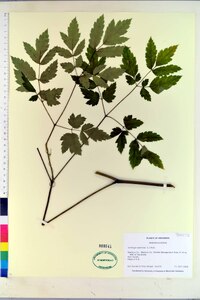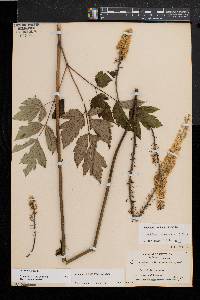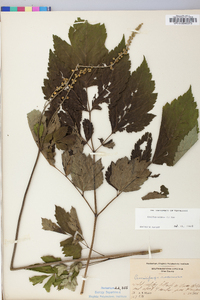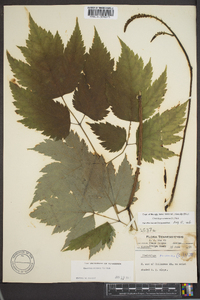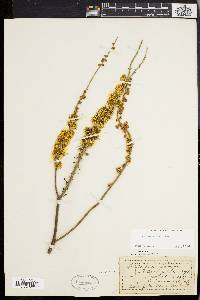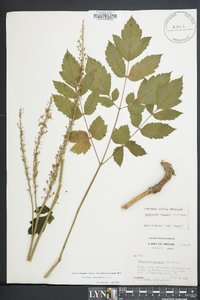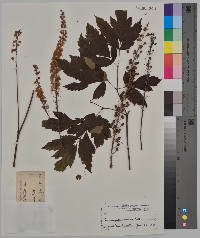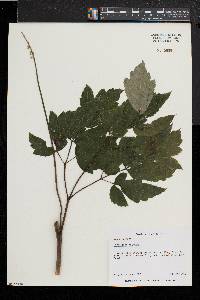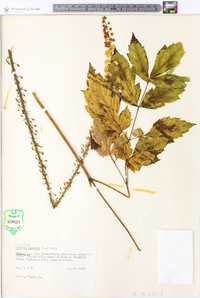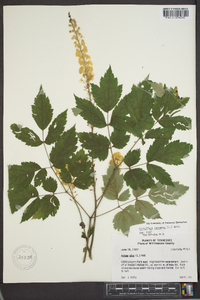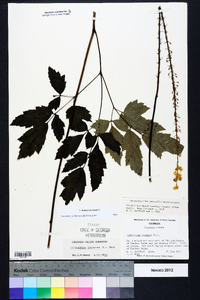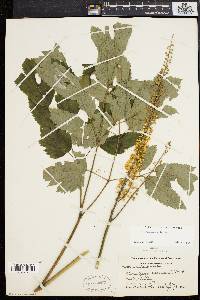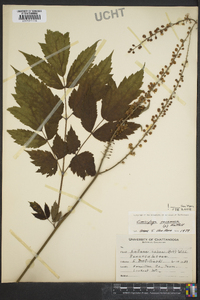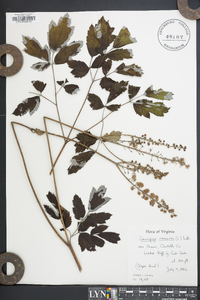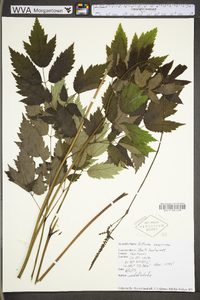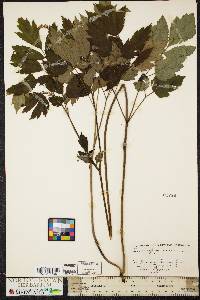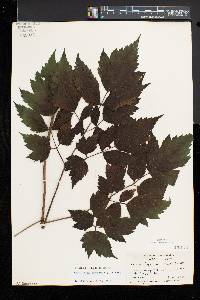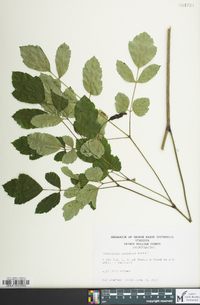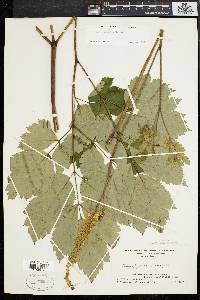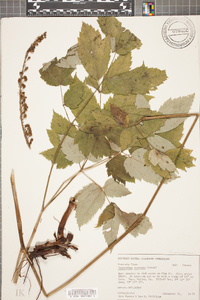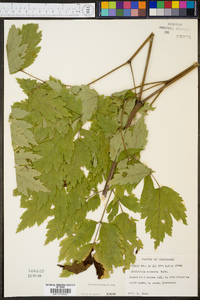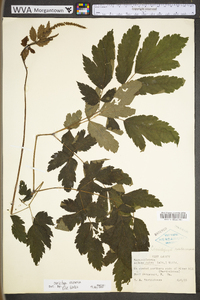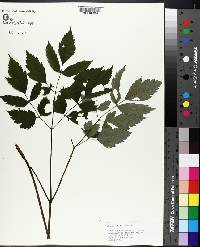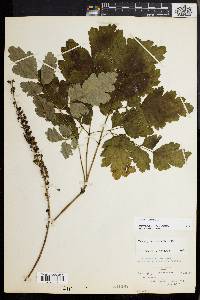Actaea racemosa
|
|
|
|
Family: Ranunculaceae
Black Bugbane
[Actaea racemosa var. dissecta (A. Gray) J. Compton, moreActaea racemosa var. racemosa L., Cimicifuga racemosa (L.) Nutt., Cimicifuga racemosa var. dissecta A. Gray, Cimicifuga racemosa var. racemosa , Cimicifuga racemosa var. racemosa francemosa francemosa, Cimicifuga serpentaria Pursh] |
Stems 75-250 cm, glabrous. Leaves: petiole angled or ± terete, 15-60 cm, usually not grooved abaxially, glabrous. Leaf blade 2-3-ternately compound; leaflets 20-70; terminal leaflet of central segment ovate to obovate, 3-lobed, 6-15 × 6-16.5 cm, with 3 prominent veins arising basally, base somewhat cuneate to somewhat cordate, margins dentate to deeply dentate-serrate or incised, apex acute to acuminate, surfaces glabrous, abaxially rarely pubescent on veins; other leaflets 4-12 × 3-8 cm. Inflorescences erect panicles of 4-9 wandlike, racemelike branches, 10-60 cm, distally pubescent; bracts 1, subtending pedicel, subulate, 3-4 mm; pedicel 4-10 mm, pubescent, bracteoles absent. Flowers: sepals 4, greenish white; petals (1-)4(-8), white, oblong, ca. 3 mm, clawed; nectary basal; stamens 55-110; filaments 5-10 mm; pistils 1(-2), sessile, ± pubescent; style short, thick; stigma 0.5 mm wide. Follicles 1, sessile, ovoid, ± laterally compressed, 5-10 mm, thick walled. Seeds brown, hemispheric, 3 mm, smooth or ± rough-ridged, without scales. 2 n = 16. Flowering summer (Jun-Sep). Moist, mixed deciduous forests, wooded slopes, ravines, creek margins, thickets, moist meadowlands, forest margins, and especially mountainous terrain; 0-1500 m; Ont.; Ala., Ark., Conn., Del., D.C., Ga., Ill., Ind., Ky., Md., Mass., Mo., N.J., N.Y., N.C., Ohio, Pa., S.C., Tenn., Va., W.Va. Maine and Vermont specimens probably were planted originally. Several varieties (A. Gray et al. 1878-1897, vol. 1(1,1), pp. 53-55) or forms (M. L. Fernald 1950) have been named. Specimens with extremely dissected leaves from Connecticut to Delaware and Virginia have been called Cimicifuga racemosa var. dissecta A. Gray, or C . racemosa forma dissecta (A. Gray) Fernald. Of the approximately 2500 specimens of C . racemosa examined, only twelve represent var. dissecta , and only two of those have flowers or fruits. Because of the limited knowledge concerning the dissected-leaf form, and because plants similar to those referred to by Gray and Fernald have not been collected in this century, the form is of uncertain taxonomic significance. Further study is needed. Native Americans used infusions of plants of Cimicifuga racemosa medicinally to stimulate menstruation, to treat rheumatic pains, coughs and colds, constipation, and kidney trouble, to make babies sleep, and to promote milk flow in women (D. E. Moerman 1986).
Plant 1-2.5 m; lvs ternate and then pinnately once or twice compound with mostly (15-)20 or more rotund to oblong, coarsely and sharply toothed or cleft lfls seldom over 1 dm, cuneate to cordate at base; infl usually branched, slender, 2-8 dm; pedicels not bracteolate; sep 5 mm; stamens 8-10 mm; staminodes oblanceolate or oblong, 2-3 mm; caducous; follicles firm-walled, transversely veined, 6-9 mm, the style becoming lateral and recurved; seeds rough but not chaffy; 2n=16. Moist or dry woods; Mass. to N.Y., O., Ind., and Mo., s. to S.C., Va., and Tenn. June-Aug. Gleason, Henry A. & Cronquist, Arthur J. 1991. Manual of vascular plants of northeastern United States and adjacent Canada. lxxv + 910 pp. ©The New York Botanical Garden. All rights reserved. Used by permission. From Flora of Indiana (1940) by Charles C. Deam Local to very local on wooded slopes in the southern counties. I have also found it on the wooded bank of Cedar Creek in Allen County. Outside the area indicated on the map, Coulter reported it from Kosciusko, Shelby, and Tippecanoe Counties, Higley & Raddin reported it from Pine, Lake County, and Schneck reported it from the Lower Wabash Valley and says: "Once common, now almost extinct." The plant is so conspicuous that if it was at all frequent I would have found it elsewhere in southern Indiana. The rhizomes and roots have been much used in medicine and since the plant is so conspicuous I fear "root collectors" have almost exterminated it. It is commonly known as black cohosh and to the eclectic physician as macrotys. ...... Indiana Coefficient of Conservatism: C = 9 Wetland Indicator Status: N/A Diagnostic Traits: Leaves 2-3 ternately compound; raceme inflorescence; sepals soon falling off, stamens numerous, their filaments white; follicles fruits on slender pedicels. |
|
|
|

